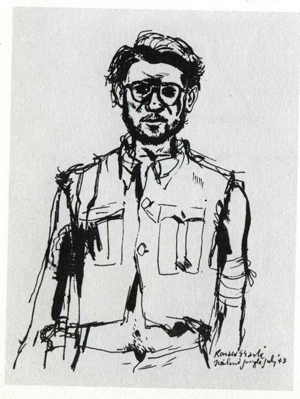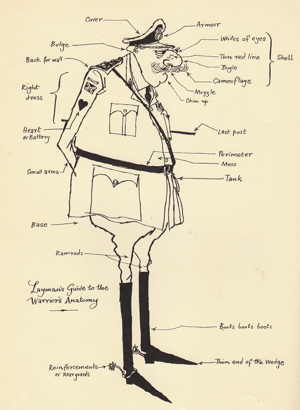
Images of Liberty and Power: The Art of War and Peace.
"War and Violence in the Work of Ronald Searle (1920-2011)"
 |
 |
| [Self Portrait in Thai Jungle July 1943] | The Anatomy of a Warrior |
Source
The English cartoonist and illustrator Ronald Searle died on 31 December 2011. He is unfortunately best remembered for his drawings about the fictional British public school for girls "St. Trinians" which he conceived while a captive of the Japanese during WW2. He regretted the fame and typecasting which came from this early success and moved to Paris then the south of France in order to concentrate on his book illustrations and cartoons. Many of the following illustrations come from the collection in the Imperial War Museum or Perpetua - Ronald Searle Tribute <http://ronaldsearle.blogspot.com/>
War and Violence in the Work of Ronald Searle (1920-2011)

[Self Portrait in Thai Jungle July 1943]

[Searle in 1954]
Introduction
The English cartoonist and illustrator Ronald Searle died on 31 December 2011. He is unfortunately best remembered for his drawings about the fictional British public school for girls "St. Trinians" which he conceived while a captive of the Japanese during WW2. He regretted the fame and typecasting which came from this early success and moved to Paris then the south of France in order to concentrate on his book illustrations and cartoons. Many of the following illustrations come from the collection in the Imperial War Museum or Perpetua - Ronald Searle Tribute <http://ronaldsearle.blogspot.com/>

[Victory on the Hockey Field] [See a larger version of this image]
I came across the other side of his work when I read his book To the Kwai - and Back: War Drawings, 1939-1945 (Collins and Imperial War Museum, 1986) when I was researching the art which emerged from the POW and concentration camps of WW2. His collection of eyewitness drawings of life in Changi Prison in Singapore and the work camps of the notorious Thai-Burma railway is extraordinary. He secretly documented his experiences and hid them from his guards by placing them under the mattresses of soldiers who were dying from cholera. The brutality and disregard for human life which he experienced first hand led him to ask himself the question - "could this happen to people in my home country, or is this something peculiar to the Japanese people and their culture?" His answer seems to be that it is a universal phenomenon.

[Dead man on a barbed wire fence, Singapore 1942] [See a larger version of this image]
His stroke of genius was to imagine a typical English private school for girls where the girls behaved in a violent manner towards their peers and their teachers. Behind the apparently humorous hijinks of the girls was a darker view of human nature in which violence, torture, and moral collapse was the order of the day. Searle did his first cartoons of the girls of St. Trinians while he was a prisoner and sold them to magazines upon his return to civilian life. They subsequently appeared in books and then as films and made him a fortune.

[The "Head Girl" Rachel] [See a larger version of this image]
After his move to Paris in 1961 Searle was very successful with his work on magazine covers, cartoons, book illustrations and other art work. I have selected a number of works which illustrate his interest in the military and the political events of his day. He explicitly acknowledged the influence of people like Francisco Goya, Honoré Daumier, George Grosz, and Pablo Picasso, all of who were also "political" in one way or another.

[A cartoon from Le Monde - "The Sower"] [See a larger version of this image]
The following pictures come from "To the Kwai and Back"

["Cholera Lines" 1943] [See a larger version of this image]

[Torturing prisoners for Fun at Lunch Time 1943] [See a larger version of this image]

[Prisoners were forced to sign an oath of obedience] [See a larger version of this image]
Images about St. Trinians girl school
Here are some more images about St. Trinians girl school. A "battle cry" was written for the girls which goes as follows:
Maidens of St Trinian's, gird your armour on.
Grab the nearest weapon; never mind which one.
The battle's to the strongest; might is always right.
Trample on the weakest; glory in their plight.St Trinian's! St Trinian's! Our battle cry.
St Trinian's! St Trinian's! Will never die.Stride towards your fortune boldly on your way,
Never once forgetting there's one born every day.
Let our motto be broadcast: "get your blow in first!"
She who draws the sword last always comes off worst.
The large drawing below of "The Fall of St. Trinians" is a veritable battle painting in the style of the 17th century French engraver Jacques Callot who meticulously documented the battles and guerrilla fighting of the Thirty Years War, such as "The Siege of Breda".

[The Fall of St. Trinians] [See a larger version of this image]

[Detail from Jacques Callot, "The Siege of Breda" (1628)] [See a larger version of this image]

[The teacher asks the girls who set fire to the East Wing, 1944]

["Not Angles but Engels"] [See a larger version of this image]
Robert Graves wrote a "School Hymn for St. Trinians" which was illustrated by Searle:

[See a larger version of this image]

[Teachers complaining about the failure of the cleaners to keep the corridors clean] [See a larger version of this image]
Some other cartoons and illustrations which deal with political and military issues
Here are some other cartoons and illustrations which deal with political and military issues:

[The Anatomy of a Warrior] [See a larger version of this image]


[Ethnic Cleansing] [See a larger version of this image]
The image below is very much in the style of Honoré Daumier's bitter cartoons of the German Wars of Unification during the 1860s, especially "Peace Idyll".

[After the Atomic Apocalypse] [See a larger version of this image]
[Daumier, "Peace Idyll"]
Some some miscellaneous pictures
Here are some miscellaneous pictures which I found interesting and/or amusing:
[A drawing of a deer in the style of Picasso's horse in Guernica]
[Wounded Horse from Picasso's "Guernica" (1937)]

[London: Revolt in Trafalgar Square, 1964] [See a larger version of this image]
The image below is the reverse of the Scandinavian idea of the Yule Goat which takes from the children at Christmas. Here the children hijack Santa and seize the toys themselves. See this post.

[Robbing Santa: "This one is for you, this one for me"] [See a larger version of this image]